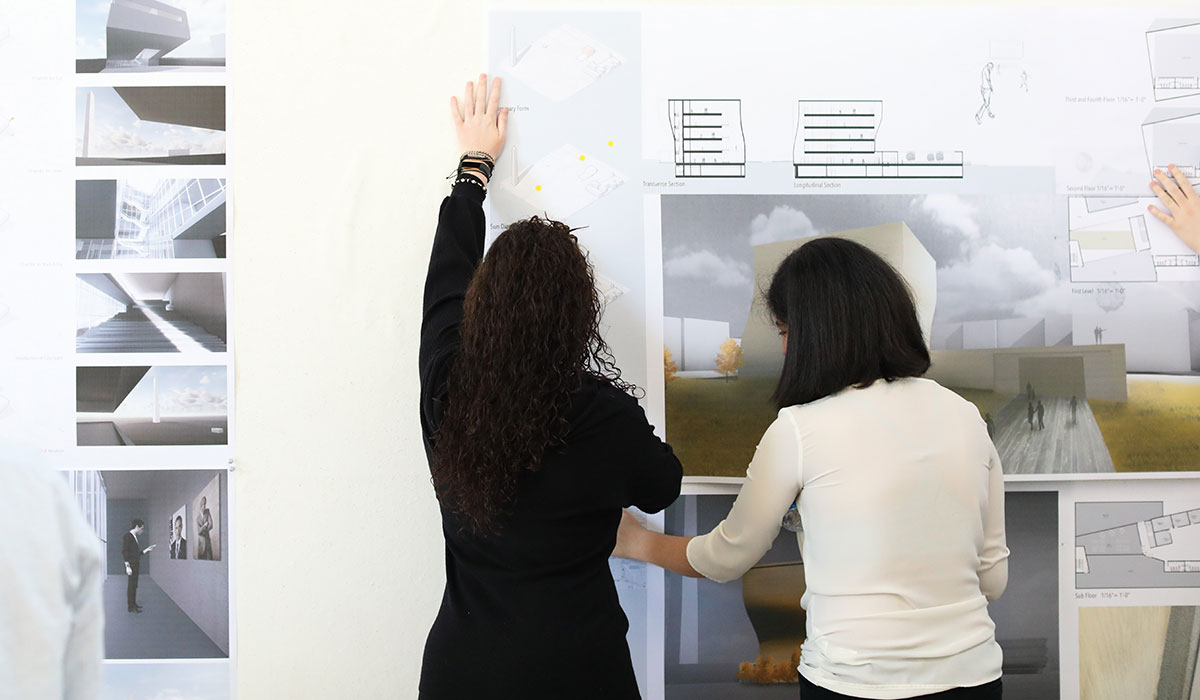Integrated Path to Architectural Licensure (IPAL)
The Integrated Path to Architectural Licensure (IPAL) is a program to help students achieve licensure expediently. For qualified students ready for the challenge, IPAL offers academic and practical experience at a significantly faster pace than a traditional sequence for earning an architectural license.
All U.S. jurisdictions require licensure before a person can commence architectural services. Becoming a licensed architect (Registered Architect) allows individuals to legally use the title “architect” and signifies to the public that they have successfully completed the education and examinations necessary to competently practice architecture. IPAL provides students the opportunity to complete requirements for licensure while earning their degree. The initiative encourages NAAB-accredited programs to incorporate the Architectural Experience Program™ (AXP™) and provides the opportunity to take the Architect Registration Examination® (ARE®) while completing academic curricula. The IPAL option does not replace the NAAB-accredited program, but adds an alternative track within an already existing program (www.ncarb.org/ipal).
The School of Architecture and Planning is accredited by the National Architectural Accreditation Board (NAAB), which works in conjunction with the National Council of Architectural Registration Boards (NCARB). Together these organizations approve all educational requirements for architectural licensure. NCARB oversees the IPAL initiative, but individual schools are responsible for managing their own curricula.
Our IPAL track allows you to complete the three required components for architectural registration by earning a degree via a NAAB-accredited institution, acquiring required experience through 3,740 hours of paid internships, and providing opportunities to take the total six (6) licensing examinations by the time you earn your M.Arch. degree. Upon completion of these three components, you are eligible to be licensed in the City of Washington, District of Columbia. Once licensed, you may pursue license reciprocity in any other state throughout the country.
More than 135 NAAB-accredited schools of architecture exist around the country, but only 21 have IPAL programs. Catholic University’s School of Architecture and Planning has a unique IPAL program that is one of the first programs accepted and launched in 2017 and is one of the most active. The primary reasons for our successful program include:
- Curriculum: IPAL students take the same classes as students on the traditional path
- Location: Our school works closely with many local firms. Washington, D.C., has 500+ architectural firms varying in size from small to large offices, most within a few Metro stops from campus!
Frequently Asked Questions
- Does my undergraduate scholarship continue into the graduate portion of IPAL? Catholic University awards undergraduate scholarships for eight semesters of study. The final three semesters of IPAL coursework are graduate study. At the graduate level, scholarships are awarded by the School of Architecture and Planning. Scholarship amount is based on GPA and portfolio.
- Do I need to stay in Washington, D.C., for my internship? Students may choose an internship wherever they please. A Registered Architect must supervise the internship. Many students decide where to intern based on housing arrangements, while others make the decision based on the professional firm with which they want to work. The School of Architecture and Planning has a robust network of alumni and supportive practitioners in the Washington, D.C., region who regularly recruit our students prior to graduation.
- Can you tell me about how I can earn AXP internship hours? Yes, please see this document
- Will you help me find an internship? Yes, we will host resume and portfolio workshops as well as a career fair. In addition, students are encouraged to reach out to their professors for contacts. However, it is ultimately up to each IPAL student to secure an internship.
- What if I can't find an internship? Typically our students do not have any issue finding an internship. However, if an IPAL student is having difficulties, they will be encouraged to apply to more firms, reach out to their professors, and consider Setting O opportunities.
- Can you tell me more about taking the ARE exams? Yes, please see these two documents: ARE 5 Guidelines and ARE Handbook.
- Will you help me pass the exams? Yes, we will support you in your efforts by providing a strong architectural education as well as subscriptions to Black Spectacles and Amber Book software. However, it is ultimately up to each IPAL student to study the material until they feel confident in their ability to pass each exam.
Featured Stories
IPAL Student Michael Matthews Featured by NCARB
Michael Matthews shares his unique experiences and opportunities at Catholic University of America as well as advice for prospective students with NCARB.
View story here.
Sara Cangarlu: Experincing Benefits of the IPAL Program Firsthand
Sara Cangarlu shares her experience of laanding a full-time paid internship last year at a Washington, D.C., firm, where she was assigned to work on a major project — the design of a sports entertainment complex in Buffalo, NY.
Read more here.

